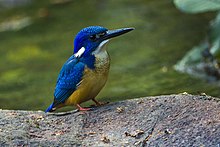Half-collared kingfisher
| Half-collared kingfisher | |
|---|---|

| |
| Scientific classification | |
| Domain: | Eukaryota |
| Kingdom: | Animalia |
| Phylum: | Chordata |
| Class: | Aves |
| Order: | Coraciiformes |
| Family: | Alcedinidae |
| Subfamily: | Alcedininae |
| Genus: | Alcedo |
| Species: | A. semitorquata
|
| Binomial name | |
| Alcedo semitorquata Swainson, 1823
| |
The half-collared kingfisher (Alcedo semitorquata) is a kingfisher in the subfamily Alcedininae that is found in southern and eastern Africa. It feeds almost exclusively on fish and frequents streams, rivers and larger bodies of water with dense shoreline vegetation.[2]
The half-collared kingfisher was described by the English ornithologist William Swainson in 1823 and given its current binomial name Alcedo semitorquata.[3] The word Alcedo is the Latin for a "kingfisher". The specific epithet semitorquata is from the Latin semi- for "half" or "small" and torquatus for "collared".[4] The blue-eared kingfisher is one of seven species in the genus Alcedo and is most closely related to the shining-blue kingfisher (Alcedo quadribrachys).[5][6]
It is known to sometimes vocalize while approaching its nest, but the purpose or advantage of this behavior is unclear.[7]
Description
[edit]The half-collared kingfisher is a medium-sized kingfisher. It is around 18 cm (7.1 in) in length with a weight of 35–40 g (1.2–1.4 oz). It has blue upperparts, a white throat and pale orange underparts. The head has alternating light blue and dark blue bands running across the crown and each side of the neck has a creamy white stripe. The dark blue patches on either side of the neck form a half collar. The legs and feet are red. The sexes are very similar but the bill of the male is entirely black while the female has some red at the base of the lower mandible.[2]
References
[edit]- ^ BirdLife International (2016). "Alcedo semitorquata". IUCN Red List of Threatened Species. 2016: e.T22683033A92974101. doi:10.2305/IUCN.UK.2016-3.RLTS.T22683033A92974101.en. Retrieved 12 November 2021.
- ^ a b Fry, C. Hilary; Fry, Kathie; Harris, Alan (1992). Kingfishers, Bee-eaters, and Rollers. London: Christopher Helm. pp. 222–223. ISBN 978-0-7136-8028-7.
- ^ Swainson, William (1823). Zoological Illustrations, or original figures and descriptions of new, rare, or interesting Animals, selected chiefly from the classes of ornithology, entomology, and conchology arrainged according to their apparent affinities. Vol. 3. London: Printed by R. and A. Taylor for Baldwin, Cradock, Joy and W. Wood. Plate 151.
- ^ Jobling, James A. (2010). The Helm Dictionary of Scientific Bird Names. London: Christopher Helm. pp. 40, 353. ISBN 978-1-4081-2501-4.
- ^ Gill, Frank; Donsker, David, eds. (2017). "Rollers, ground rollers & kingfishers". World Bird List Version 7.3. International Ornithologists' Union. Retrieved 3 December 2017.
- ^ Andersen, M.J.; McCullough, J.M.; Mauck III, W.M.; Smith, B.T.; Moyle, R.G. (2017). "A phylogeny of kingfishers reveals an Indomalayan origin and elevated rates of diversification on oceanic islands". Journal of Biogeography. 45 (2): 1–13. doi:10.1111/jbi.13139.
- ^ Hendricks, Paul; Hendricks, Lisa M. (2022-04-06). "Context of rattle-call use by adult Belted Kingfishers (Megaceryle alcyon) near their nests". The Wilson Journal of Ornithology. 133 (4). doi:10.1676/19-00099. ISSN 1559-4491.
External links
[edit]- Half-collared kingfisher - Species text in The Atlas of Southern African Birds.
- Animal Diversity Web's Taxon Tree

